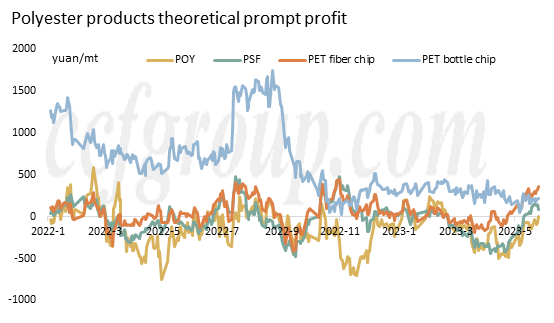Does PET fiber chip replaces PET bottle chip to become a star product ?
In May, as raw material prices gradually fell, the cost of polymerization gradually decreased, and this also gave the polyester factories a slight relief.
Interestingly, looking at the industrial chain price differential as a whole, it has been discovered that recently the most profitable polyester product is actually PET fiber chip. There have even been reports of individual factories experiencing tight supplies of fiber chip, leading to a phenomenon of increasing O/R. So, has PET fiber chip become the star product to replace bottle chips?
![DBV0BU7VQQNAZ_O$5B)]1UG.png DBV0BU7VQQNAZ_O$5B)]1UG.png](https://pic.ccf.com.cn/2023/05/2023053002435052.png)
There are several possible explanations for this question, which we will explore further.
As an adjustment product, PET fiber chip sometimes has a this-for-that relationship with the spinning sector, meaning that, in theory, if the polymerization remains unchanged, the polyester plants can produce less (or more) PFY or PSF, and more (or less) PET fiber chip.
![)M)O[FV9YM][~@}CR4D2103.png )M)O[FV9YM][~@}CR4D2103.png](https://pic.ccf.com.cn/2023/05/20230530024409536.png)
One may be a temporary supply-demand reversal.
Last year, under inventory pressure in the fourth quarter, polyester units had a significant reduction in O/R, with the spinning sector falling particularly sharp. PFY O/R dropped to 50% or even slightly below, but fiber chip O/R did not see an equivalent decline.
This situation is the opposite this year, as the pandemic recedes, spinning factories are showing a high degree of initiative, and fiber chip production has been somewhat compressed. Although a number of new PFY units were put into production in the first half of the year, the output of PET fiber chip (before new PFY plants begin to produce PFY, the line will first produce PET fiber chip) did not accumulate significantly, as spinning lines are quickly integrated.
In other words, from a supply perspective, PET fiber chip did not increase output in sync with other links, but output of some unit did shrink to some extent. There were also some fiber chip units that were temporarily shut down for other reasons, contributing to factors.
However, from a demand perspective, since March and April of this year, downstream chip spun operating rate (as well as other fiber chip demand links) has seen a noticeable rebound, which means that fiber chip demand is also increasing. This alternation of supply and demand has led to a gradual tightening of PET fiber chip supply. In fact, it is not just virgin PET fiber chips, the recycling market has long been complaining of a shortage of raw materials.
Another explanation is the long-term supply and demand perspective.
In the long run, PET fiber chip, as intermediate products, do not face sustained expansionary pressures, so their price differential space is relatively controllable compared to other varieties.
From the running in recent years, it is basically impossible to see a complete set of fiber chip unit (new fiber chip unit are basically bright chip lines to support industrial yarn). There is only occasional increases in output caused by new unit commissioning, and after the spinning capacity is fully commissioned, this part of the increase will disappear again, meaning that the supply and demand of fiber chip can be adjusted for the long term.
In terms of demand, having gone through the period of capacity elimination competition with direct spun, chip spinning factories have basically stabilized. They mainly adopted a differentiation or customization route, having their own survival strategies. More often, their fluctuations follow the trend of demand, and sometimes their running may be more stable (relatively less expansionary impact).
The current fiber chip market is a relatively stable market, with a relatively high proportion of large factory contract sales, and spot sales proportions are not as large as for PSF. In the event of a temporary shortage of spot supplies, it can be relatively easily reflected. In addition, fiber chip market also has brand differentiation, which sometimes leads to structural differentiation.
However, although profits improved during certain periods, factories may ramp up O/R, but won't specifically put online many pure fiber chip units.
On the one hand, under the context of a relatively large total polymer capacity and limited demand growth, it is not too difficult to alleviate the situation of tight supply; on the other hand, compared to other products, the profitability of fiber chip can only be said to be relatively stable, and it is not possible to achieve both volume and price at the same time.
Instead, the market will be alert to temporary supply risks. For example, during the period of sudden increases in new polyester units, or when demand is weak, if other products are experiencing high sales pressures, it may lead to a short-term increase in chip output, bringing pressure to the market.

- Top keywords
- Cotton Price
- Cotton Futures Price
- Cotton Futures
- CZCE
- PTA Futures Price
- Chemical Fiber
- Polyester Prices
- Wool price
- PTA Futures
- Shengze Silk
- China
- Yarn Price
- price
- China Textile City
- Fibre Price
- Benzene Price
- Cotton
- Index
- Cotton Index
- PTA
- fabric price
- NYMEX
- Top 10
- textile industry
- Spot Cotton
- Cotton Yarn
- Polyester Price
- Futures
- PTA Price
- cotton yarn price

